A Detailed Leadership Analysis of General George S. Patton Jr. (Essay)
VerifiedAdded on 2023/06/10
|12
|4512
|313
Essay
AI Summary
This essay provides a comprehensive analysis of General George S. Patton Jr.'s leadership during World War II. It begins with a psychobiographical overview, examining his early life, family background, and influences that shaped his personality and worldview. The analysis delves into Patton's personality traits, highlighting his ambition, discipline, and hard-driving approach. The essay further explores his worldview, including his beliefs about military strategy, political relationships, and his commitment to serving his country. It then examines Patton's leadership system, focusing on his communication style, the authority and impact model he employed, and his ability to inspire troops. The essay highlights his famous motivational speeches and his use of rhetoric. The analysis also covers Patton's outlook, including his aggressive attitude and his intolerance for shortcomings. Overall, the essay assesses Patton's leadership effectiveness, considering both his successes and controversies, and provides insights into his lasting impact on military leadership.
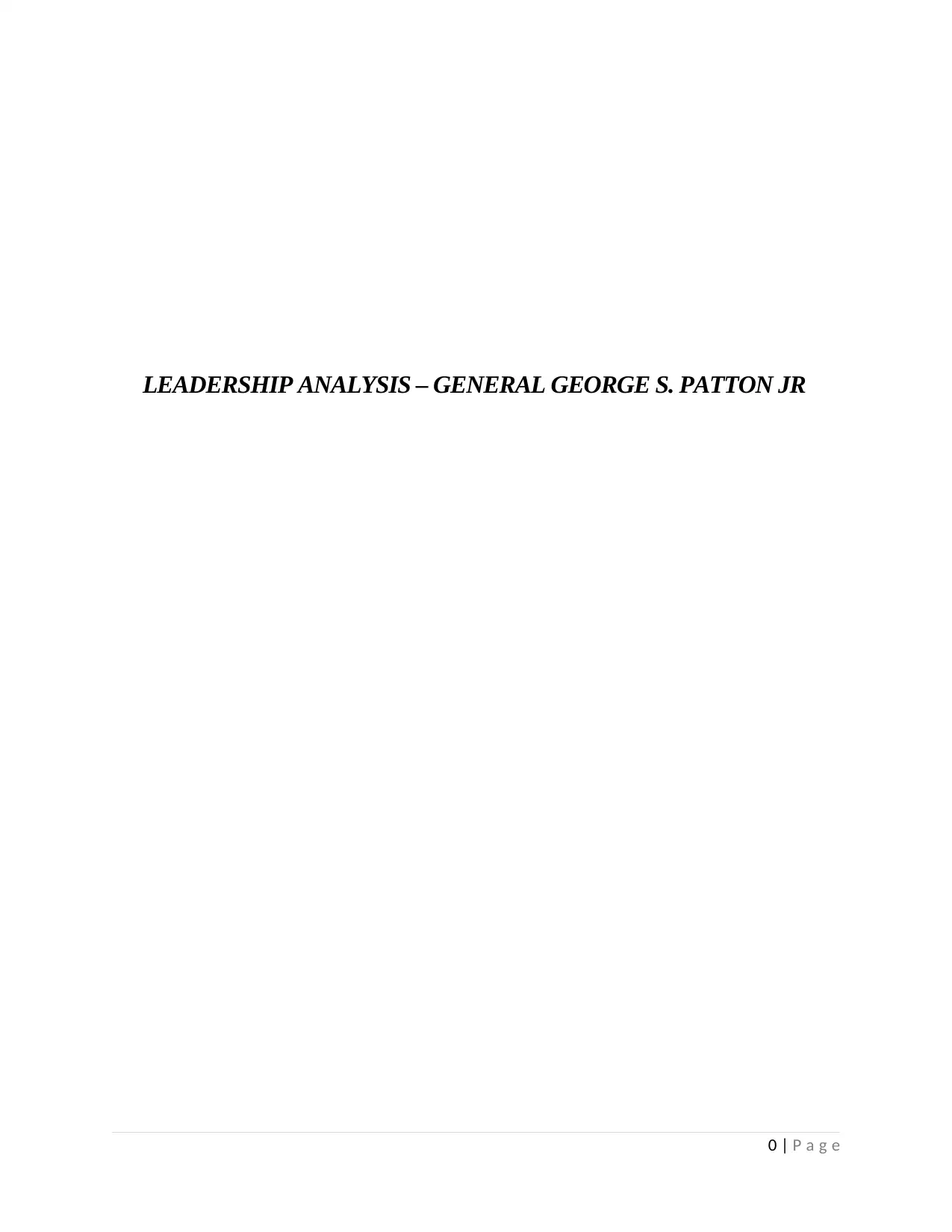
LEADERSHIP ANALYSIS – GENERAL GEORGE S. PATTON JR
0 | P a g e
0 | P a g e
Paraphrase This Document
Need a fresh take? Get an instant paraphrase of this document with our AI Paraphraser
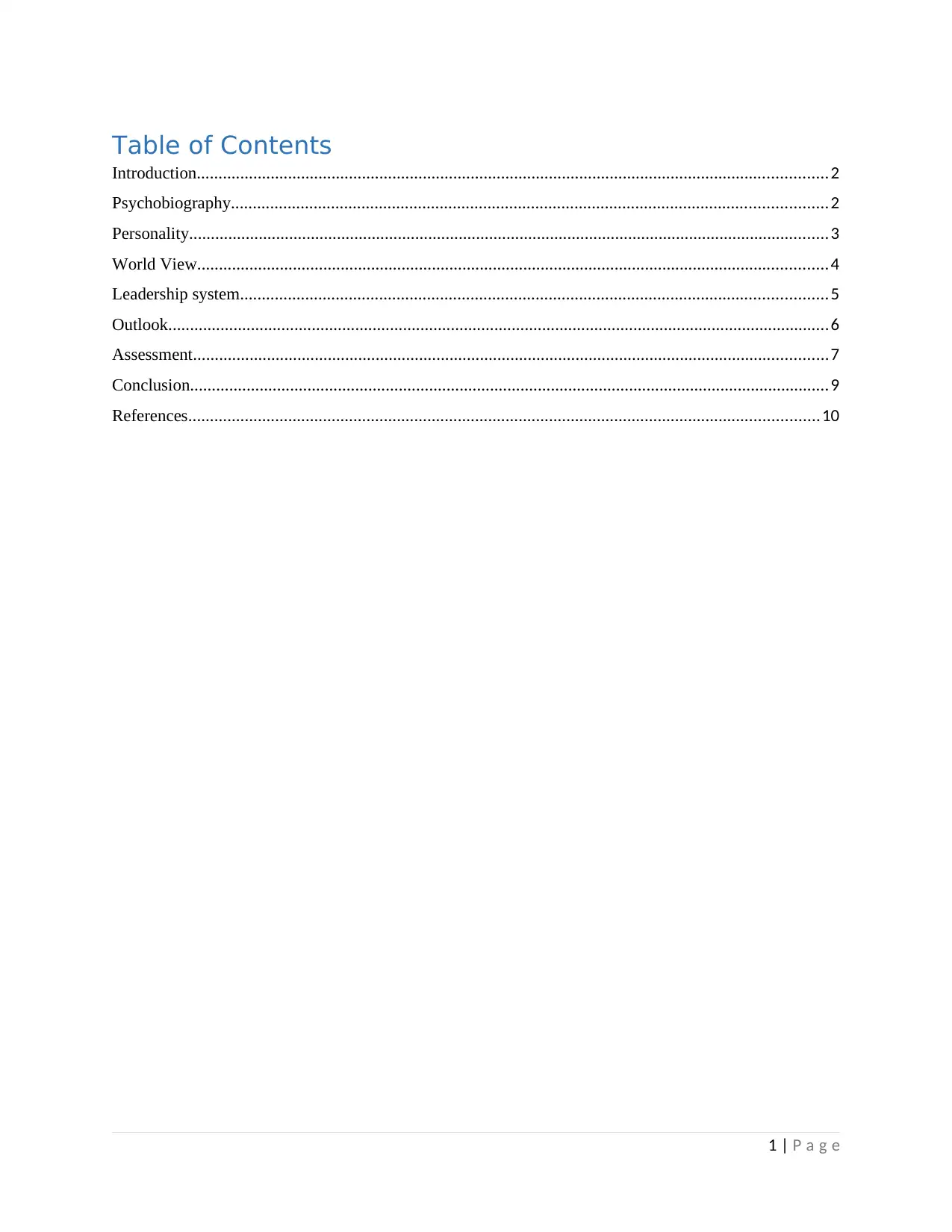
Table of Contents
Introduction.................................................................................................................................................2
Psychobiography.........................................................................................................................................2
Personality...................................................................................................................................................3
World View.................................................................................................................................................4
Leadership system.......................................................................................................................................5
Outlook........................................................................................................................................................6
Assessment..................................................................................................................................................7
Conclusion...................................................................................................................................................9
References.................................................................................................................................................10
1 | P a g e
Introduction.................................................................................................................................................2
Psychobiography.........................................................................................................................................2
Personality...................................................................................................................................................3
World View.................................................................................................................................................4
Leadership system.......................................................................................................................................5
Outlook........................................................................................................................................................6
Assessment..................................................................................................................................................7
Conclusion...................................................................................................................................................9
References.................................................................................................................................................10
1 | P a g e
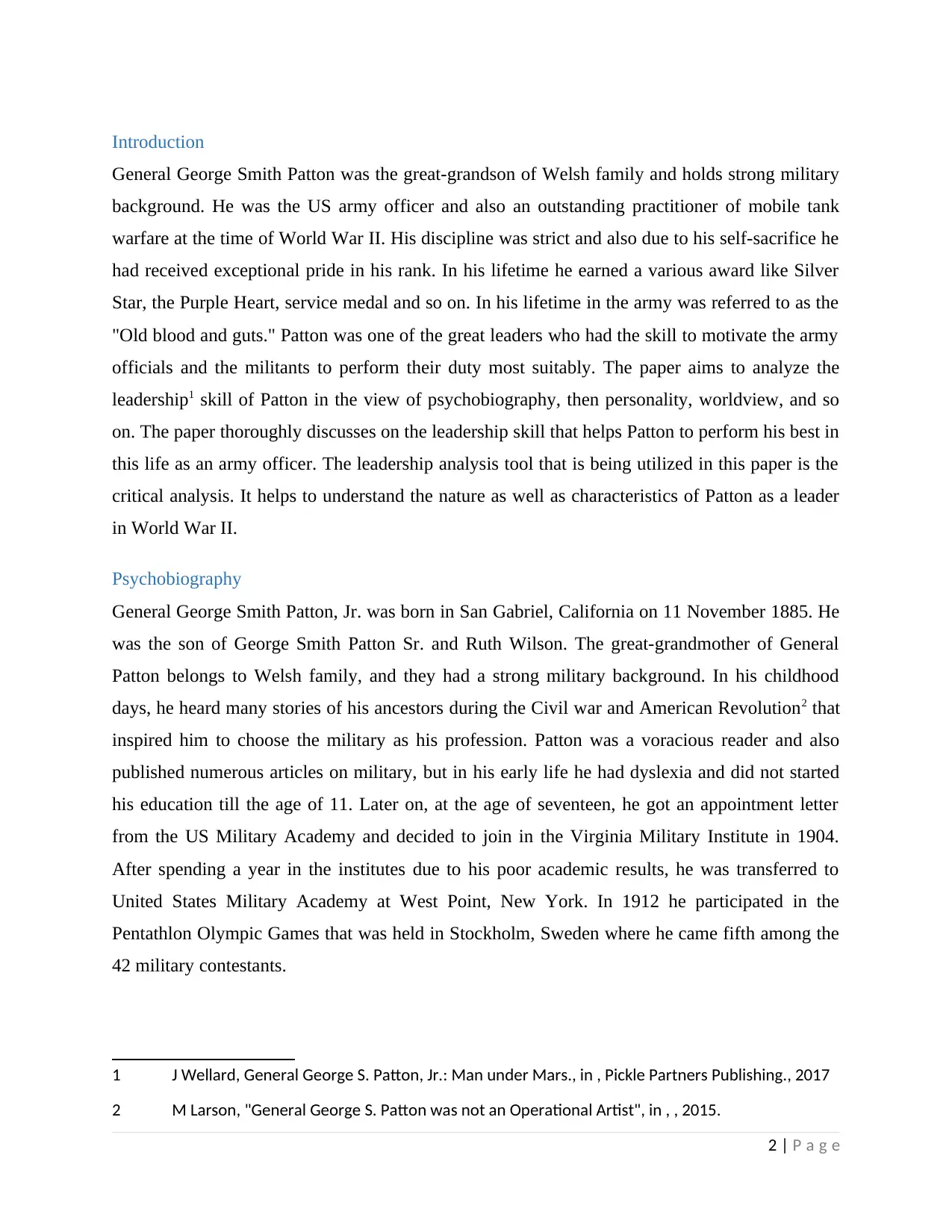
Introduction
General George Smith Patton was the great-grandson of Welsh family and holds strong military
background. He was the US army officer and also an outstanding practitioner of mobile tank
warfare at the time of World War II. His discipline was strict and also due to his self-sacrifice he
had received exceptional pride in his rank. In his lifetime he earned a various award like Silver
Star, the Purple Heart, service medal and so on. In his lifetime in the army was referred to as the
"Old blood and guts." Patton was one of the great leaders who had the skill to motivate the army
officials and the militants to perform their duty most suitably. The paper aims to analyze the
leadership1 skill of Patton in the view of psychobiography, then personality, worldview, and so
on. The paper thoroughly discusses on the leadership skill that helps Patton to perform his best in
this life as an army officer. The leadership analysis tool that is being utilized in this paper is the
critical analysis. It helps to understand the nature as well as characteristics of Patton as a leader
in World War II.
Psychobiography
General George Smith Patton, Jr. was born in San Gabriel, California on 11 November 1885. He
was the son of George Smith Patton Sr. and Ruth Wilson. The great-grandmother of General
Patton belongs to Welsh family, and they had a strong military background. In his childhood
days, he heard many stories of his ancestors during the Civil war and American Revolution2 that
inspired him to choose the military as his profession. Patton was a voracious reader and also
published numerous articles on military, but in his early life he had dyslexia and did not started
his education till the age of 11. Later on, at the age of seventeen, he got an appointment letter
from the US Military Academy and decided to join in the Virginia Military Institute in 1904.
After spending a year in the institutes due to his poor academic results, he was transferred to
United States Military Academy at West Point, New York. In 1912 he participated in the
Pentathlon Olympic Games that was held in Stockholm, Sweden where he came fifth among the
42 military contestants.
1 J Wellard, General George S. Patton, Jr.: Man under Mars., in , Pickle Partners Publishing., 2017
2 M Larson, "General George S. Patton was not an Operational Artist", in , , 2015.
2 | P a g e
General George Smith Patton was the great-grandson of Welsh family and holds strong military
background. He was the US army officer and also an outstanding practitioner of mobile tank
warfare at the time of World War II. His discipline was strict and also due to his self-sacrifice he
had received exceptional pride in his rank. In his lifetime he earned a various award like Silver
Star, the Purple Heart, service medal and so on. In his lifetime in the army was referred to as the
"Old blood and guts." Patton was one of the great leaders who had the skill to motivate the army
officials and the militants to perform their duty most suitably. The paper aims to analyze the
leadership1 skill of Patton in the view of psychobiography, then personality, worldview, and so
on. The paper thoroughly discusses on the leadership skill that helps Patton to perform his best in
this life as an army officer. The leadership analysis tool that is being utilized in this paper is the
critical analysis. It helps to understand the nature as well as characteristics of Patton as a leader
in World War II.
Psychobiography
General George Smith Patton, Jr. was born in San Gabriel, California on 11 November 1885. He
was the son of George Smith Patton Sr. and Ruth Wilson. The great-grandmother of General
Patton belongs to Welsh family, and they had a strong military background. In his childhood
days, he heard many stories of his ancestors during the Civil war and American Revolution2 that
inspired him to choose the military as his profession. Patton was a voracious reader and also
published numerous articles on military, but in his early life he had dyslexia and did not started
his education till the age of 11. Later on, at the age of seventeen, he got an appointment letter
from the US Military Academy and decided to join in the Virginia Military Institute in 1904.
After spending a year in the institutes due to his poor academic results, he was transferred to
United States Military Academy at West Point, New York. In 1912 he participated in the
Pentathlon Olympic Games that was held in Stockholm, Sweden where he came fifth among the
42 military contestants.
1 J Wellard, General George S. Patton, Jr.: Man under Mars., in , Pickle Partners Publishing., 2017
2 M Larson, "General George S. Patton was not an Operational Artist", in , , 2015.
2 | P a g e
⊘ This is a preview!⊘
Do you want full access?
Subscribe today to unlock all pages.

Trusted by 1+ million students worldwide
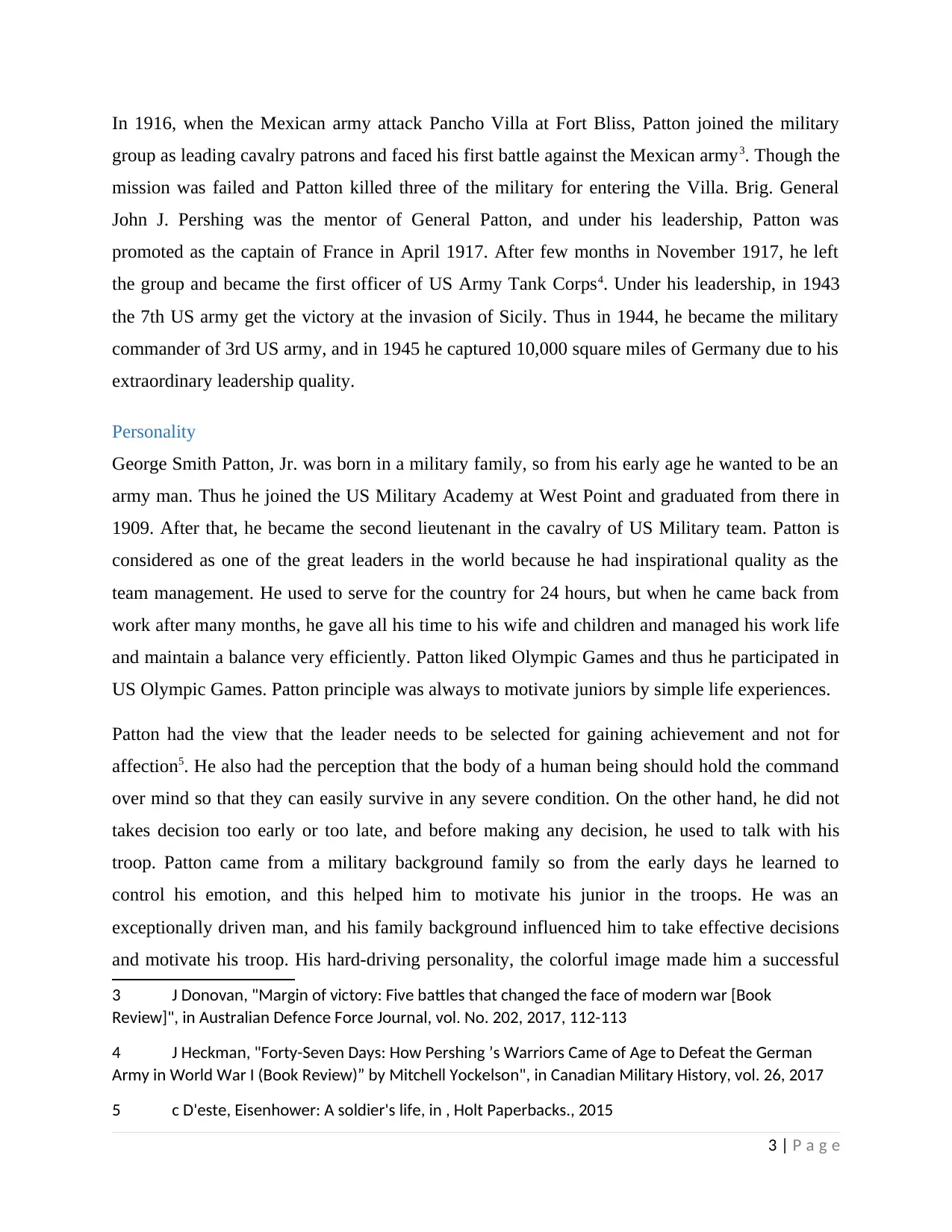
In 1916, when the Mexican army attack Pancho Villa at Fort Bliss, Patton joined the military
group as leading cavalry patrons and faced his first battle against the Mexican army3. Though the
mission was failed and Patton killed three of the military for entering the Villa. Brig. General
John J. Pershing was the mentor of General Patton, and under his leadership, Patton was
promoted as the captain of France in April 1917. After few months in November 1917, he left
the group and became the first officer of US Army Tank Corps4. Under his leadership, in 1943
the 7th US army get the victory at the invasion of Sicily. Thus in 1944, he became the military
commander of 3rd US army, and in 1945 he captured 10,000 square miles of Germany due to his
extraordinary leadership quality.
Personality
George Smith Patton, Jr. was born in a military family, so from his early age he wanted to be an
army man. Thus he joined the US Military Academy at West Point and graduated from there in
1909. After that, he became the second lieutenant in the cavalry of US Military team. Patton is
considered as one of the great leaders in the world because he had inspirational quality as the
team management. He used to serve for the country for 24 hours, but when he came back from
work after many months, he gave all his time to his wife and children and managed his work life
and maintain a balance very efficiently. Patton liked Olympic Games and thus he participated in
US Olympic Games. Patton principle was always to motivate juniors by simple life experiences.
Patton had the view that the leader needs to be selected for gaining achievement and not for
affection5. He also had the perception that the body of a human being should hold the command
over mind so that they can easily survive in any severe condition. On the other hand, he did not
takes decision too early or too late, and before making any decision, he used to talk with his
troop. Patton came from a military background family so from the early days he learned to
control his emotion, and this helped him to motivate his junior in the troops. He was an
exceptionally driven man, and his family background influenced him to take effective decisions
and motivate his troop. His hard-driving personality, the colorful image made him a successful
3 J Donovan, "Margin of victory: Five battles that changed the face of modern war [Book
Review]", in Australian Defence Force Journal, vol. No. 202, 2017, 112-113
4 J Heckman, "Forty-Seven Days: How Pershing ’s Warriors Came of Age to Defeat the German
Army in World War I (Book Review)” by Mitchell Yockelson", in Canadian Military History, vol. 26, 2017
5 c D'este, Eisenhower: A soldier's life, in , Holt Paperbacks., 2015
3 | P a g e
group as leading cavalry patrons and faced his first battle against the Mexican army3. Though the
mission was failed and Patton killed three of the military for entering the Villa. Brig. General
John J. Pershing was the mentor of General Patton, and under his leadership, Patton was
promoted as the captain of France in April 1917. After few months in November 1917, he left
the group and became the first officer of US Army Tank Corps4. Under his leadership, in 1943
the 7th US army get the victory at the invasion of Sicily. Thus in 1944, he became the military
commander of 3rd US army, and in 1945 he captured 10,000 square miles of Germany due to his
extraordinary leadership quality.
Personality
George Smith Patton, Jr. was born in a military family, so from his early age he wanted to be an
army man. Thus he joined the US Military Academy at West Point and graduated from there in
1909. After that, he became the second lieutenant in the cavalry of US Military team. Patton is
considered as one of the great leaders in the world because he had inspirational quality as the
team management. He used to serve for the country for 24 hours, but when he came back from
work after many months, he gave all his time to his wife and children and managed his work life
and maintain a balance very efficiently. Patton liked Olympic Games and thus he participated in
US Olympic Games. Patton principle was always to motivate juniors by simple life experiences.
Patton had the view that the leader needs to be selected for gaining achievement and not for
affection5. He also had the perception that the body of a human being should hold the command
over mind so that they can easily survive in any severe condition. On the other hand, he did not
takes decision too early or too late, and before making any decision, he used to talk with his
troop. Patton came from a military background family so from the early days he learned to
control his emotion, and this helped him to motivate his junior in the troops. He was an
exceptionally driven man, and his family background influenced him to take effective decisions
and motivate his troop. His hard-driving personality, the colorful image made him a successful
3 J Donovan, "Margin of victory: Five battles that changed the face of modern war [Book
Review]", in Australian Defence Force Journal, vol. No. 202, 2017, 112-113
4 J Heckman, "Forty-Seven Days: How Pershing ’s Warriors Came of Age to Defeat the German
Army in World War I (Book Review)” by Mitchell Yockelson", in Canadian Military History, vol. 26, 2017
5 c D'este, Eisenhower: A soldier's life, in , Holt Paperbacks., 2015
3 | P a g e
Paraphrase This Document
Need a fresh take? Get an instant paraphrase of this document with our AI Paraphraser
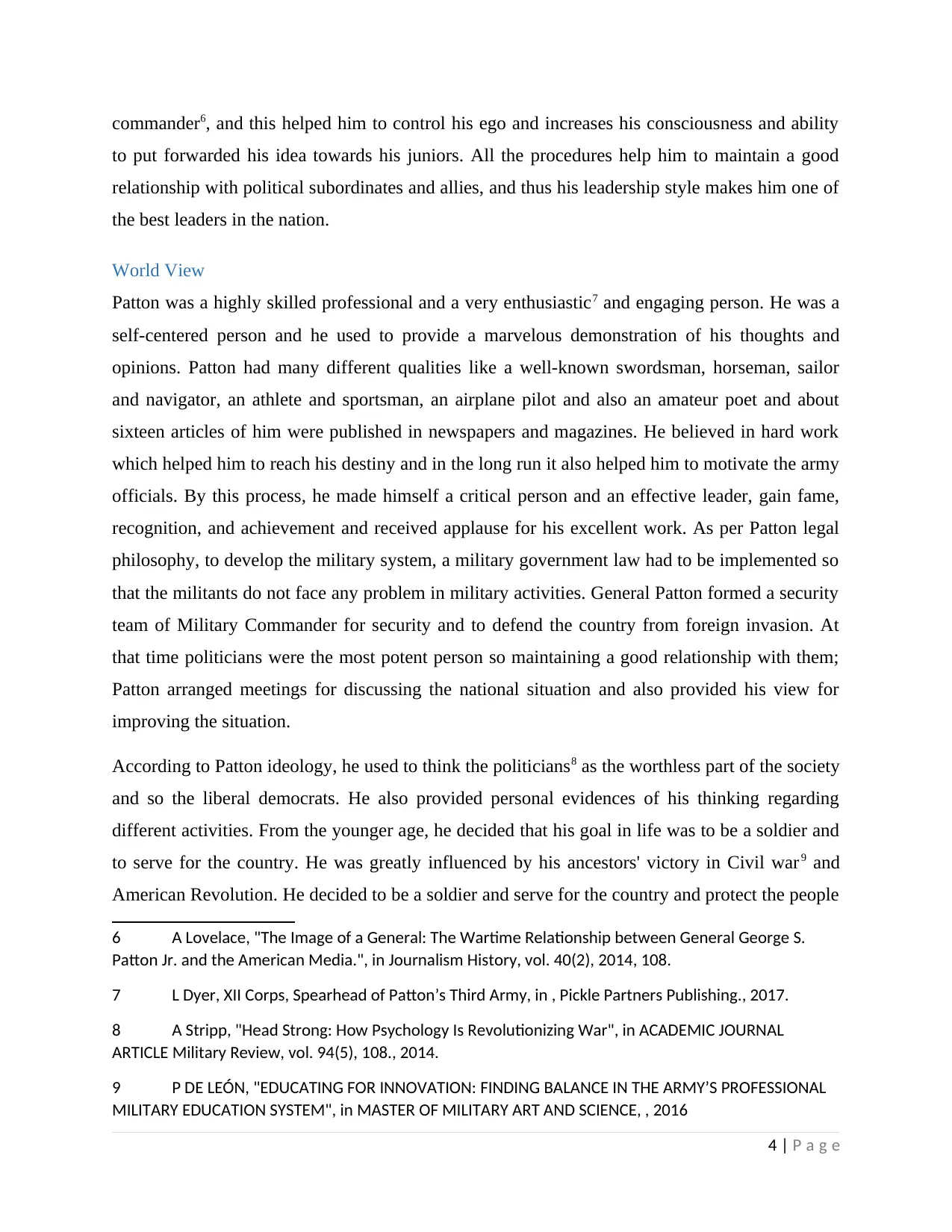
commander6, and this helped him to control his ego and increases his consciousness and ability
to put forwarded his idea towards his juniors. All the procedures help him to maintain a good
relationship with political subordinates and allies, and thus his leadership style makes him one of
the best leaders in the nation.
World View
Patton was a highly skilled professional and a very enthusiastic7 and engaging person. He was a
self-centered person and he used to provide a marvelous demonstration of his thoughts and
opinions. Patton had many different qualities like a well-known swordsman, horseman, sailor
and navigator, an athlete and sportsman, an airplane pilot and also an amateur poet and about
sixteen articles of him were published in newspapers and magazines. He believed in hard work
which helped him to reach his destiny and in the long run it also helped him to motivate the army
officials. By this process, he made himself a critical person and an effective leader, gain fame,
recognition, and achievement and received applause for his excellent work. As per Patton legal
philosophy, to develop the military system, a military government law had to be implemented so
that the militants do not face any problem in military activities. General Patton formed a security
team of Military Commander for security and to defend the country from foreign invasion. At
that time politicians were the most potent person so maintaining a good relationship with them;
Patton arranged meetings for discussing the national situation and also provided his view for
improving the situation.
According to Patton ideology, he used to think the politicians8 as the worthless part of the society
and so the liberal democrats. He also provided personal evidences of his thinking regarding
different activities. From the younger age, he decided that his goal in life was to be a soldier and
to serve for the country. He was greatly influenced by his ancestors' victory in Civil war9 and
American Revolution. He decided to be a soldier and serve for the country and protect the people
6 A Lovelace, "The Image of a General: The Wartime Relationship between General George S.
Patton Jr. and the American Media.", in Journalism History, vol. 40(2), 2014, 108.
7 L Dyer, XII Corps, Spearhead of Patton’s Third Army, in , Pickle Partners Publishing., 2017.
8 A Stripp, "Head Strong: How Psychology Is Revolutionizing War", in ACADEMIC JOURNAL
ARTICLE Military Review, vol. 94(5), 108., 2014.
9 P DE LEÓN, "EDUCATING FOR INNOVATION: FINDING BALANCE IN THE ARMY’S PROFESSIONAL
MILITARY EDUCATION SYSTEM", in MASTER OF MILITARY ART AND SCIENCE, , 2016
4 | P a g e
to put forwarded his idea towards his juniors. All the procedures help him to maintain a good
relationship with political subordinates and allies, and thus his leadership style makes him one of
the best leaders in the nation.
World View
Patton was a highly skilled professional and a very enthusiastic7 and engaging person. He was a
self-centered person and he used to provide a marvelous demonstration of his thoughts and
opinions. Patton had many different qualities like a well-known swordsman, horseman, sailor
and navigator, an athlete and sportsman, an airplane pilot and also an amateur poet and about
sixteen articles of him were published in newspapers and magazines. He believed in hard work
which helped him to reach his destiny and in the long run it also helped him to motivate the army
officials. By this process, he made himself a critical person and an effective leader, gain fame,
recognition, and achievement and received applause for his excellent work. As per Patton legal
philosophy, to develop the military system, a military government law had to be implemented so
that the militants do not face any problem in military activities. General Patton formed a security
team of Military Commander for security and to defend the country from foreign invasion. At
that time politicians were the most potent person so maintaining a good relationship with them;
Patton arranged meetings for discussing the national situation and also provided his view for
improving the situation.
According to Patton ideology, he used to think the politicians8 as the worthless part of the society
and so the liberal democrats. He also provided personal evidences of his thinking regarding
different activities. From the younger age, he decided that his goal in life was to be a soldier and
to serve for the country. He was greatly influenced by his ancestors' victory in Civil war9 and
American Revolution. He decided to be a soldier and serve for the country and protect the people
6 A Lovelace, "The Image of a General: The Wartime Relationship between General George S.
Patton Jr. and the American Media.", in Journalism History, vol. 40(2), 2014, 108.
7 L Dyer, XII Corps, Spearhead of Patton’s Third Army, in , Pickle Partners Publishing., 2017.
8 A Stripp, "Head Strong: How Psychology Is Revolutionizing War", in ACADEMIC JOURNAL
ARTICLE Military Review, vol. 94(5), 108., 2014.
9 P DE LEÓN, "EDUCATING FOR INNOVATION: FINDING BALANCE IN THE ARMY’S PROFESSIONAL
MILITARY EDUCATION SYSTEM", in MASTER OF MILITARY ART AND SCIENCE, , 2016
4 | P a g e
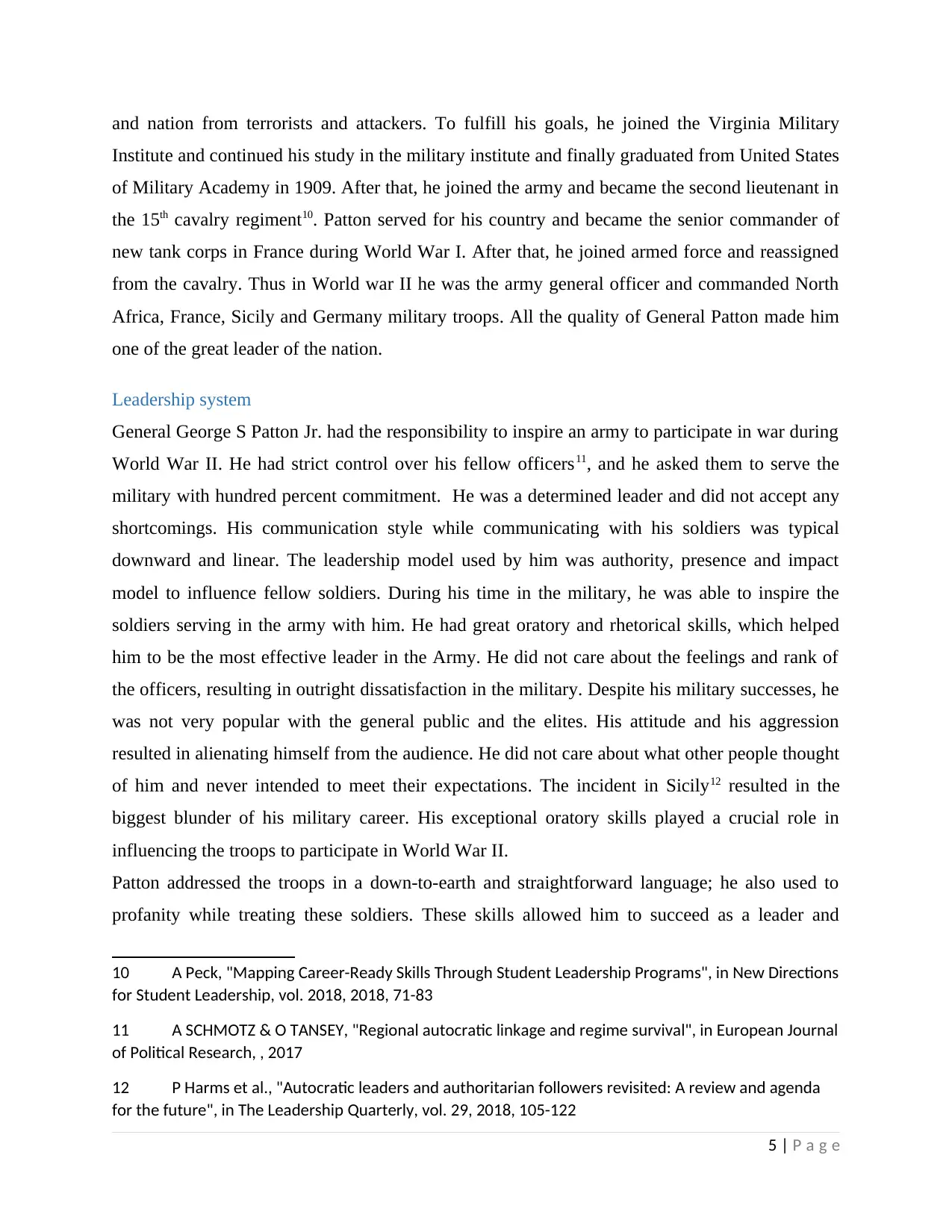
and nation from terrorists and attackers. To fulfill his goals, he joined the Virginia Military
Institute and continued his study in the military institute and finally graduated from United States
of Military Academy in 1909. After that, he joined the army and became the second lieutenant in
the 15th cavalry regiment10. Patton served for his country and became the senior commander of
new tank corps in France during World War I. After that, he joined armed force and reassigned
from the cavalry. Thus in World war II he was the army general officer and commanded North
Africa, France, Sicily and Germany military troops. All the quality of General Patton made him
one of the great leader of the nation.
Leadership system
General George S Patton Jr. had the responsibility to inspire an army to participate in war during
World War II. He had strict control over his fellow officers11, and he asked them to serve the
military with hundred percent commitment. He was a determined leader and did not accept any
shortcomings. His communication style while communicating with his soldiers was typical
downward and linear. The leadership model used by him was authority, presence and impact
model to influence fellow soldiers. During his time in the military, he was able to inspire the
soldiers serving in the army with him. He had great oratory and rhetorical skills, which helped
him to be the most effective leader in the Army. He did not care about the feelings and rank of
the officers, resulting in outright dissatisfaction in the military. Despite his military successes, he
was not very popular with the general public and the elites. His attitude and his aggression
resulted in alienating himself from the audience. He did not care about what other people thought
of him and never intended to meet their expectations. The incident in Sicily12 resulted in the
biggest blunder of his military career. His exceptional oratory skills played a crucial role in
influencing the troops to participate in World War II.
Patton addressed the troops in a down-to-earth and straightforward language; he also used to
profanity while treating these soldiers. These skills allowed him to succeed as a leader and
10 A Peck, "Mapping Career-Ready Skills Through Student Leadership Programs", in New Directions
for Student Leadership, vol. 2018, 2018, 71-83
11 A SCHMOTZ & O TANSEY, "Regional autocratic linkage and regime survival", in European Journal
of Political Research, , 2017
12 P Harms et al., "Autocratic leaders and authoritarian followers revisited: A review and agenda
for the future", in The Leadership Quarterly, vol. 29, 2018, 105-122
5 | P a g e
Institute and continued his study in the military institute and finally graduated from United States
of Military Academy in 1909. After that, he joined the army and became the second lieutenant in
the 15th cavalry regiment10. Patton served for his country and became the senior commander of
new tank corps in France during World War I. After that, he joined armed force and reassigned
from the cavalry. Thus in World war II he was the army general officer and commanded North
Africa, France, Sicily and Germany military troops. All the quality of General Patton made him
one of the great leader of the nation.
Leadership system
General George S Patton Jr. had the responsibility to inspire an army to participate in war during
World War II. He had strict control over his fellow officers11, and he asked them to serve the
military with hundred percent commitment. He was a determined leader and did not accept any
shortcomings. His communication style while communicating with his soldiers was typical
downward and linear. The leadership model used by him was authority, presence and impact
model to influence fellow soldiers. During his time in the military, he was able to inspire the
soldiers serving in the army with him. He had great oratory and rhetorical skills, which helped
him to be the most effective leader in the Army. He did not care about the feelings and rank of
the officers, resulting in outright dissatisfaction in the military. Despite his military successes, he
was not very popular with the general public and the elites. His attitude and his aggression
resulted in alienating himself from the audience. He did not care about what other people thought
of him and never intended to meet their expectations. The incident in Sicily12 resulted in the
biggest blunder of his military career. His exceptional oratory skills played a crucial role in
influencing the troops to participate in World War II.
Patton addressed the troops in a down-to-earth and straightforward language; he also used to
profanity while treating these soldiers. These skills allowed him to succeed as a leader and
10 A Peck, "Mapping Career-Ready Skills Through Student Leadership Programs", in New Directions
for Student Leadership, vol. 2018, 2018, 71-83
11 A SCHMOTZ & O TANSEY, "Regional autocratic linkage and regime survival", in European Journal
of Political Research, , 2017
12 P Harms et al., "Autocratic leaders and authoritarian followers revisited: A review and agenda
for the future", in The Leadership Quarterly, vol. 29, 2018, 105-122
5 | P a g e
⊘ This is a preview!⊘
Do you want full access?
Subscribe today to unlock all pages.

Trusted by 1+ million students worldwide

military personnel. He gave his most famous speech to Third Army of United States in 1944. In
this speech, he urged the inexperienced soldiers to fight for their motherland irrespective of their
fears. His speech encouraged them to use aggression in the field and implement consistent
offensive actions. Some of the officers thought his communication style as unprofessional13 due
to the presence of profanity. However, it became the most famous motivational speech in the
history. He used pathos in his speech to motivate the troops of the Third Army of United States.
He used the emotion of anger in most of his statements to drive the men and to convey14 that
losing the war was not acceptable. The words used by him was powerful enough to encourage
the men and participate in the battle. He used the Aristotelian model of rhetoric in his speech to
influence the men in the uniform.
Outlook
General Patton is famous for his aggressive and quirky attitude and his unpredictable behavior.
He did not tolerate any shortcomings from his subordinate officers, and he certainly did not
accept cowardice. He was a disciplined and fierce leader. However, his career was full of brash
decisions and controversies. During his childhood years, he had difficulty in reading and writing,
which could be a symptom of undiagnosed dyslexia. In the military, he influenced his soldiers to
participate in the war actively. He was not satisfied when it ended; he thought he would never
fight another battle. He was depressed and due to this depression, his started behaving
irrationally. During this time, he suffered from several physical and psychological stress, which
contributed to his behavior. He did not care about what others were thinking about him and
disregarded social rules and regulations. His actions were impulsive and aggressive, and he had
taken some wrong decisions. His outspoken nature and his strong opinions caused him to face
problems on multiple occasions. He did not have any regard about rank or position in the army,
which resulted in dissatisfaction among the other high ranking officials. From his behavior, it can
be said that he had an antisocial personality disorder.
People with an antisocial personality disorder do not have any regard for any social rules and
regulations, and they often have a charming personality. General Patton also had similar traits
13 A De Hoogh, L Greer & D Den Hartog, "Diabolical dictators or capable commanders? An
investigation of the differential effects of autocratic leadership on team performance", in The Leadership
Quarterly, vol. 26, 2015, 687-701
14 J Sanderson, General George S. Patton, Jr, in , San Francisco, Pickle Partners Publishing, 2015.
6 | P a g e
this speech, he urged the inexperienced soldiers to fight for their motherland irrespective of their
fears. His speech encouraged them to use aggression in the field and implement consistent
offensive actions. Some of the officers thought his communication style as unprofessional13 due
to the presence of profanity. However, it became the most famous motivational speech in the
history. He used pathos in his speech to motivate the troops of the Third Army of United States.
He used the emotion of anger in most of his statements to drive the men and to convey14 that
losing the war was not acceptable. The words used by him was powerful enough to encourage
the men and participate in the battle. He used the Aristotelian model of rhetoric in his speech to
influence the men in the uniform.
Outlook
General Patton is famous for his aggressive and quirky attitude and his unpredictable behavior.
He did not tolerate any shortcomings from his subordinate officers, and he certainly did not
accept cowardice. He was a disciplined and fierce leader. However, his career was full of brash
decisions and controversies. During his childhood years, he had difficulty in reading and writing,
which could be a symptom of undiagnosed dyslexia. In the military, he influenced his soldiers to
participate in the war actively. He was not satisfied when it ended; he thought he would never
fight another battle. He was depressed and due to this depression, his started behaving
irrationally. During this time, he suffered from several physical and psychological stress, which
contributed to his behavior. He did not care about what others were thinking about him and
disregarded social rules and regulations. His actions were impulsive and aggressive, and he had
taken some wrong decisions. His outspoken nature and his strong opinions caused him to face
problems on multiple occasions. He did not have any regard about rank or position in the army,
which resulted in dissatisfaction among the other high ranking officials. From his behavior, it can
be said that he had an antisocial personality disorder.
People with an antisocial personality disorder do not have any regard for any social rules and
regulations, and they often have a charming personality. General Patton also had similar traits
13 A De Hoogh, L Greer & D Den Hartog, "Diabolical dictators or capable commanders? An
investigation of the differential effects of autocratic leadership on team performance", in The Leadership
Quarterly, vol. 26, 2015, 687-701
14 J Sanderson, General George S. Patton, Jr, in , San Francisco, Pickle Partners Publishing, 2015.
6 | P a g e
Paraphrase This Document
Need a fresh take? Get an instant paraphrase of this document with our AI Paraphraser
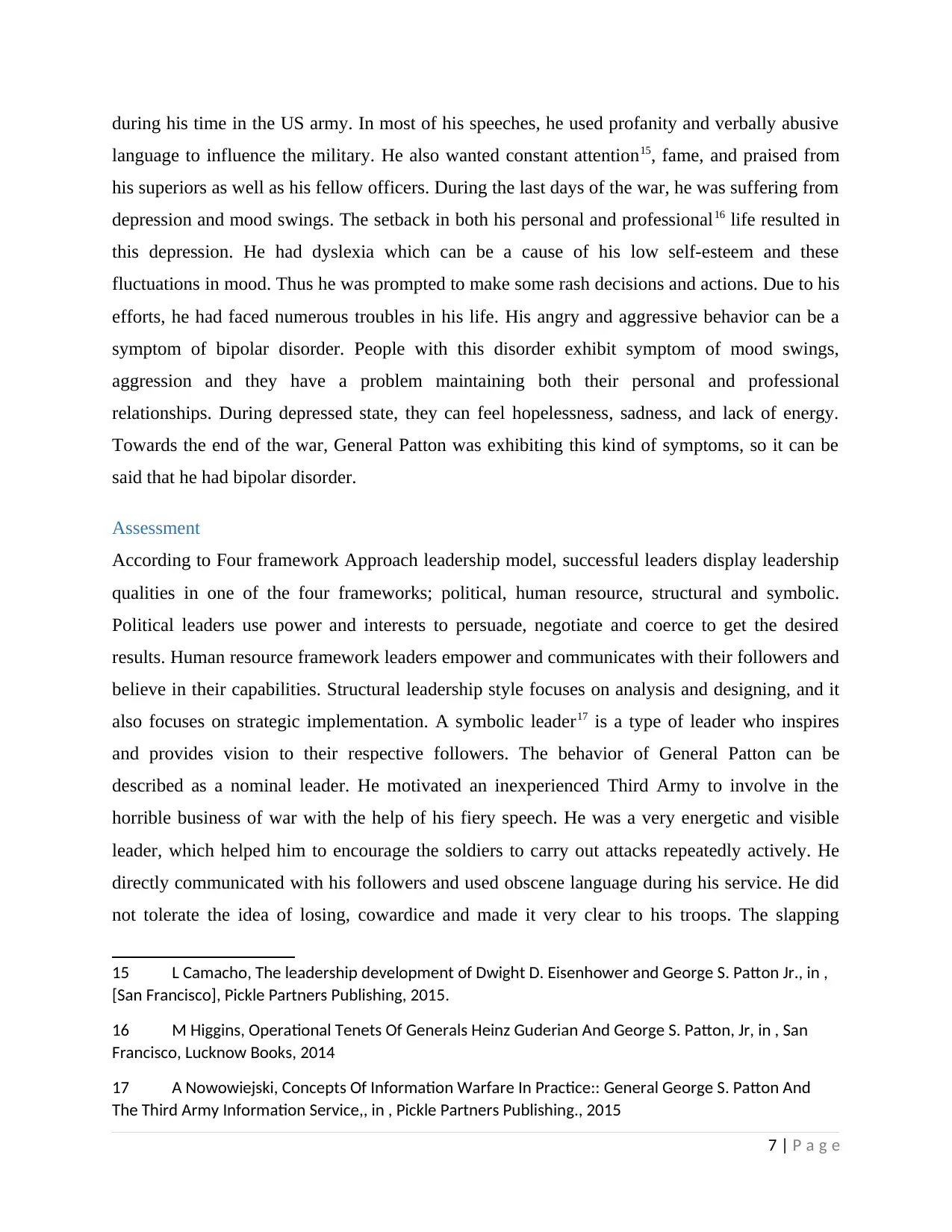
during his time in the US army. In most of his speeches, he used profanity and verbally abusive
language to influence the military. He also wanted constant attention15, fame, and praised from
his superiors as well as his fellow officers. During the last days of the war, he was suffering from
depression and mood swings. The setback in both his personal and professional16 life resulted in
this depression. He had dyslexia which can be a cause of his low self-esteem and these
fluctuations in mood. Thus he was prompted to make some rash decisions and actions. Due to his
efforts, he had faced numerous troubles in his life. His angry and aggressive behavior can be a
symptom of bipolar disorder. People with this disorder exhibit symptom of mood swings,
aggression and they have a problem maintaining both their personal and professional
relationships. During depressed state, they can feel hopelessness, sadness, and lack of energy.
Towards the end of the war, General Patton was exhibiting this kind of symptoms, so it can be
said that he had bipolar disorder.
Assessment
According to Four framework Approach leadership model, successful leaders display leadership
qualities in one of the four frameworks; political, human resource, structural and symbolic.
Political leaders use power and interests to persuade, negotiate and coerce to get the desired
results. Human resource framework leaders empower and communicates with their followers and
believe in their capabilities. Structural leadership style focuses on analysis and designing, and it
also focuses on strategic implementation. A symbolic leader17 is a type of leader who inspires
and provides vision to their respective followers. The behavior of General Patton can be
described as a nominal leader. He motivated an inexperienced Third Army to involve in the
horrible business of war with the help of his fiery speech. He was a very energetic and visible
leader, which helped him to encourage the soldiers to carry out attacks repeatedly actively. He
directly communicated with his followers and used obscene language during his service. He did
not tolerate the idea of losing, cowardice and made it very clear to his troops. The slapping
15 L Camacho, The leadership development of Dwight D. Eisenhower and George S. Patton Jr., in ,
[San Francisco], Pickle Partners Publishing, 2015.
16 M Higgins, Operational Tenets Of Generals Heinz Guderian And George S. Patton, Jr, in , San
Francisco, Lucknow Books, 2014
17 A Nowowiejski, Concepts Of Information Warfare In Practice:: General George S. Patton And
The Third Army Information Service,, in , Pickle Partners Publishing., 2015
7 | P a g e
language to influence the military. He also wanted constant attention15, fame, and praised from
his superiors as well as his fellow officers. During the last days of the war, he was suffering from
depression and mood swings. The setback in both his personal and professional16 life resulted in
this depression. He had dyslexia which can be a cause of his low self-esteem and these
fluctuations in mood. Thus he was prompted to make some rash decisions and actions. Due to his
efforts, he had faced numerous troubles in his life. His angry and aggressive behavior can be a
symptom of bipolar disorder. People with this disorder exhibit symptom of mood swings,
aggression and they have a problem maintaining both their personal and professional
relationships. During depressed state, they can feel hopelessness, sadness, and lack of energy.
Towards the end of the war, General Patton was exhibiting this kind of symptoms, so it can be
said that he had bipolar disorder.
Assessment
According to Four framework Approach leadership model, successful leaders display leadership
qualities in one of the four frameworks; political, human resource, structural and symbolic.
Political leaders use power and interests to persuade, negotiate and coerce to get the desired
results. Human resource framework leaders empower and communicates with their followers and
believe in their capabilities. Structural leadership style focuses on analysis and designing, and it
also focuses on strategic implementation. A symbolic leader17 is a type of leader who inspires
and provides vision to their respective followers. The behavior of General Patton can be
described as a nominal leader. He motivated an inexperienced Third Army to involve in the
horrible business of war with the help of his fiery speech. He was a very energetic and visible
leader, which helped him to encourage the soldiers to carry out attacks repeatedly actively. He
directly communicated with his followers and used obscene language during his service. He did
not tolerate the idea of losing, cowardice and made it very clear to his troops. The slapping
15 L Camacho, The leadership development of Dwight D. Eisenhower and George S. Patton Jr., in ,
[San Francisco], Pickle Partners Publishing, 2015.
16 M Higgins, Operational Tenets Of Generals Heinz Guderian And George S. Patton, Jr, in , San
Francisco, Lucknow Books, 2014
17 A Nowowiejski, Concepts Of Information Warfare In Practice:: General George S. Patton And
The Third Army Information Service,, in , Pickle Partners Publishing., 2015
7 | P a g e
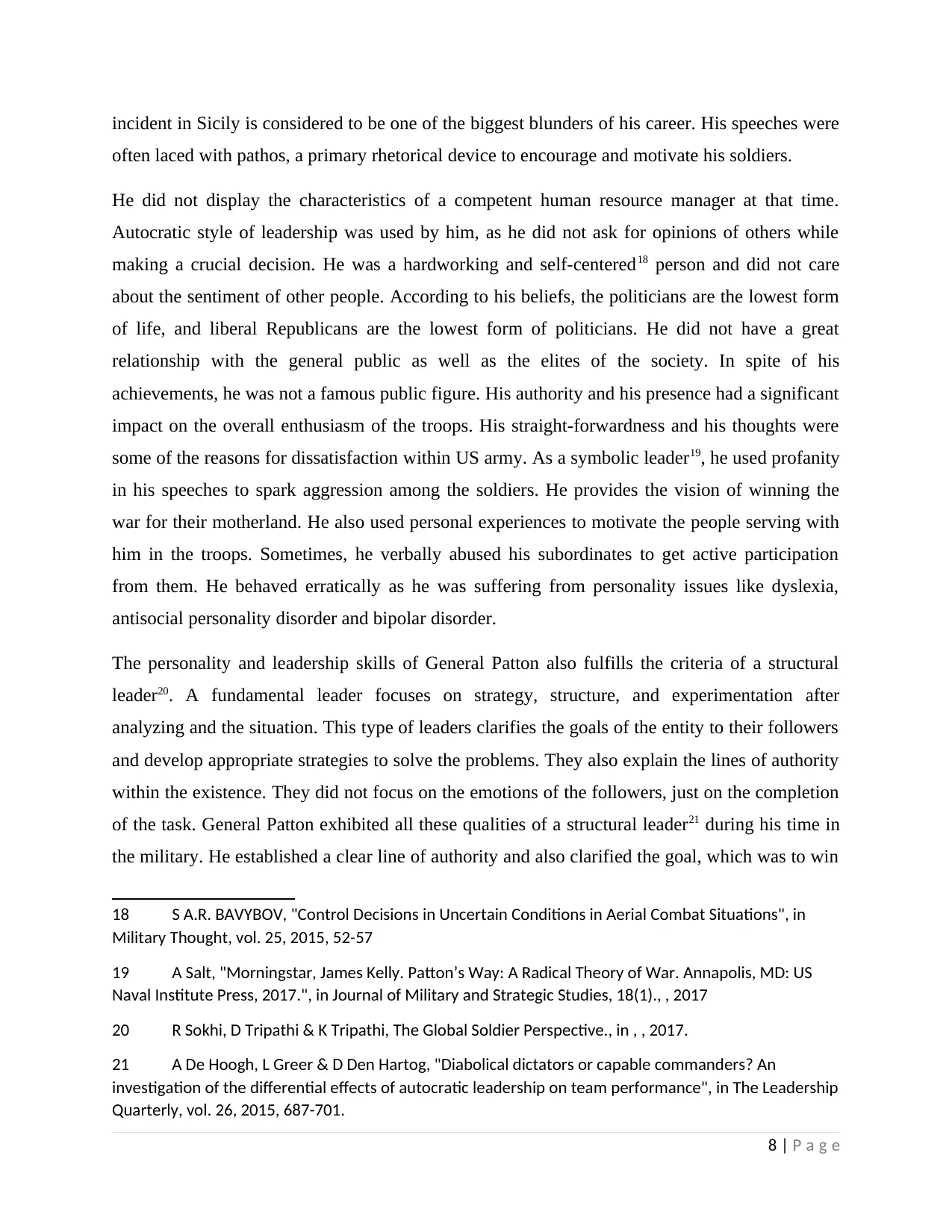
incident in Sicily is considered to be one of the biggest blunders of his career. His speeches were
often laced with pathos, a primary rhetorical device to encourage and motivate his soldiers.
He did not display the characteristics of a competent human resource manager at that time.
Autocratic style of leadership was used by him, as he did not ask for opinions of others while
making a crucial decision. He was a hardworking and self-centered18 person and did not care
about the sentiment of other people. According to his beliefs, the politicians are the lowest form
of life, and liberal Republicans are the lowest form of politicians. He did not have a great
relationship with the general public as well as the elites of the society. In spite of his
achievements, he was not a famous public figure. His authority and his presence had a significant
impact on the overall enthusiasm of the troops. His straight-forwardness and his thoughts were
some of the reasons for dissatisfaction within US army. As a symbolic leader19, he used profanity
in his speeches to spark aggression among the soldiers. He provides the vision of winning the
war for their motherland. He also used personal experiences to motivate the people serving with
him in the troops. Sometimes, he verbally abused his subordinates to get active participation
from them. He behaved erratically as he was suffering from personality issues like dyslexia,
antisocial personality disorder and bipolar disorder.
The personality and leadership skills of General Patton also fulfills the criteria of a structural
leader20. A fundamental leader focuses on strategy, structure, and experimentation after
analyzing and the situation. This type of leaders clarifies the goals of the entity to their followers
and develop appropriate strategies to solve the problems. They also explain the lines of authority
within the existence. They did not focus on the emotions of the followers, just on the completion
of the task. General Patton exhibited all these qualities of a structural leader21 during his time in
the military. He established a clear line of authority and also clarified the goal, which was to win
18 S A.R. BAVYBOV, "Control Decisions in Uncertain Conditions in Aerial Combat Situations", in
Military Thought, vol. 25, 2015, 52-57
19 A Salt, "Morningstar, James Kelly. Patton’s Way: A Radical Theory of War. Annapolis, MD: US
Naval Institute Press, 2017.", in Journal of Military and Strategic Studies, 18(1)., , 2017
20 R Sokhi, D Tripathi & K Tripathi, The Global Soldier Perspective., in , , 2017.
21 A De Hoogh, L Greer & D Den Hartog, "Diabolical dictators or capable commanders? An
investigation of the differential effects of autocratic leadership on team performance", in The Leadership
Quarterly, vol. 26, 2015, 687-701.
8 | P a g e
often laced with pathos, a primary rhetorical device to encourage and motivate his soldiers.
He did not display the characteristics of a competent human resource manager at that time.
Autocratic style of leadership was used by him, as he did not ask for opinions of others while
making a crucial decision. He was a hardworking and self-centered18 person and did not care
about the sentiment of other people. According to his beliefs, the politicians are the lowest form
of life, and liberal Republicans are the lowest form of politicians. He did not have a great
relationship with the general public as well as the elites of the society. In spite of his
achievements, he was not a famous public figure. His authority and his presence had a significant
impact on the overall enthusiasm of the troops. His straight-forwardness and his thoughts were
some of the reasons for dissatisfaction within US army. As a symbolic leader19, he used profanity
in his speeches to spark aggression among the soldiers. He provides the vision of winning the
war for their motherland. He also used personal experiences to motivate the people serving with
him in the troops. Sometimes, he verbally abused his subordinates to get active participation
from them. He behaved erratically as he was suffering from personality issues like dyslexia,
antisocial personality disorder and bipolar disorder.
The personality and leadership skills of General Patton also fulfills the criteria of a structural
leader20. A fundamental leader focuses on strategy, structure, and experimentation after
analyzing and the situation. This type of leaders clarifies the goals of the entity to their followers
and develop appropriate strategies to solve the problems. They also explain the lines of authority
within the existence. They did not focus on the emotions of the followers, just on the completion
of the task. General Patton exhibited all these qualities of a structural leader21 during his time in
the military. He established a clear line of authority and also clarified the goal, which was to win
18 S A.R. BAVYBOV, "Control Decisions in Uncertain Conditions in Aerial Combat Situations", in
Military Thought, vol. 25, 2015, 52-57
19 A Salt, "Morningstar, James Kelly. Patton’s Way: A Radical Theory of War. Annapolis, MD: US
Naval Institute Press, 2017.", in Journal of Military and Strategic Studies, 18(1)., , 2017
20 R Sokhi, D Tripathi & K Tripathi, The Global Soldier Perspective., in , , 2017.
21 A De Hoogh, L Greer & D Den Hartog, "Diabolical dictators or capable commanders? An
investigation of the differential effects of autocratic leadership on team performance", in The Leadership
Quarterly, vol. 26, 2015, 687-701.
8 | P a g e
⊘ This is a preview!⊘
Do you want full access?
Subscribe today to unlock all pages.

Trusted by 1+ million students worldwide
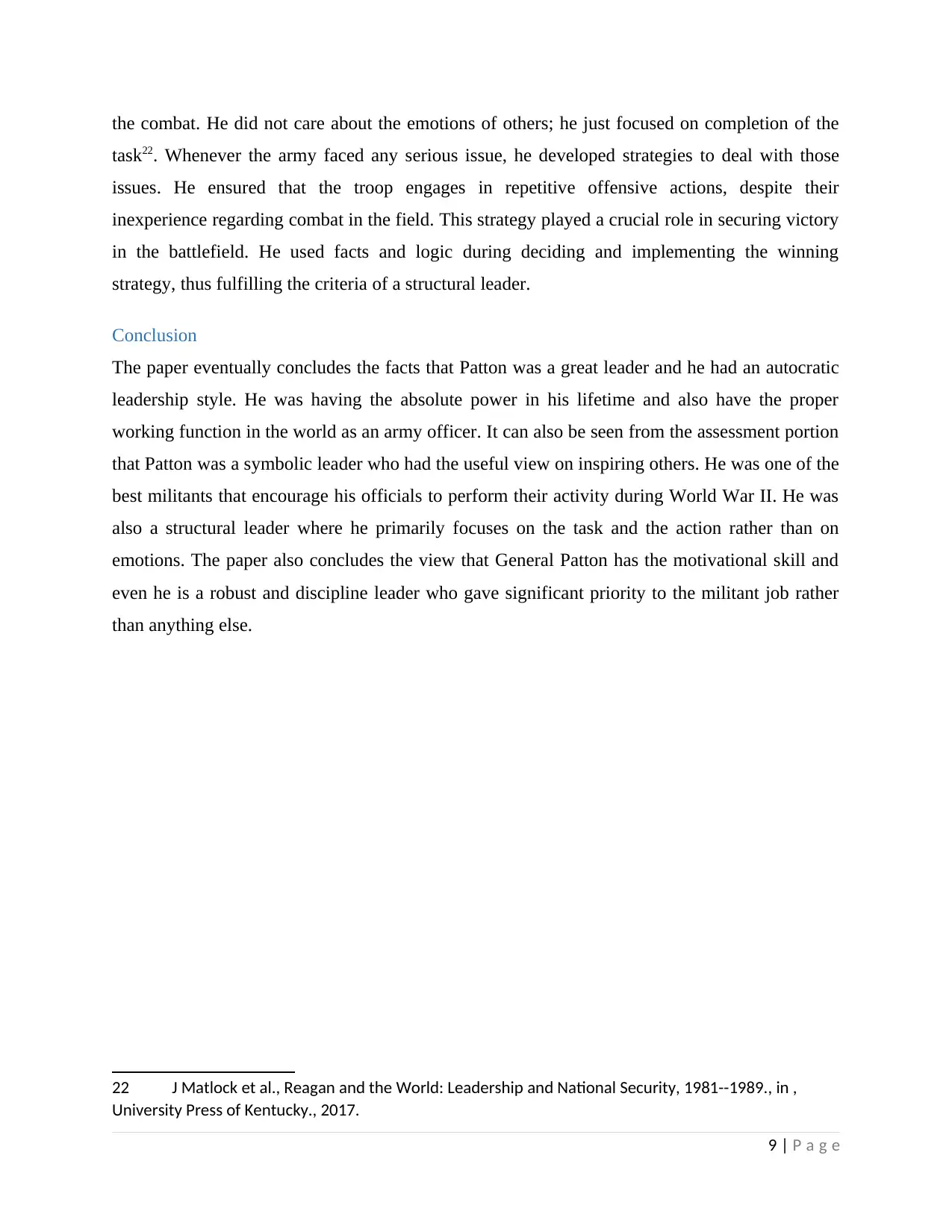
the combat. He did not care about the emotions of others; he just focused on completion of the
task22. Whenever the army faced any serious issue, he developed strategies to deal with those
issues. He ensured that the troop engages in repetitive offensive actions, despite their
inexperience regarding combat in the field. This strategy played a crucial role in securing victory
in the battlefield. He used facts and logic during deciding and implementing the winning
strategy, thus fulfilling the criteria of a structural leader.
Conclusion
The paper eventually concludes the facts that Patton was a great leader and he had an autocratic
leadership style. He was having the absolute power in his lifetime and also have the proper
working function in the world as an army officer. It can also be seen from the assessment portion
that Patton was a symbolic leader who had the useful view on inspiring others. He was one of the
best militants that encourage his officials to perform their activity during World War II. He was
also a structural leader where he primarily focuses on the task and the action rather than on
emotions. The paper also concludes the view that General Patton has the motivational skill and
even he is a robust and discipline leader who gave significant priority to the militant job rather
than anything else.
22 J Matlock et al., Reagan and the World: Leadership and National Security, 1981--1989., in ,
University Press of Kentucky., 2017.
9 | P a g e
task22. Whenever the army faced any serious issue, he developed strategies to deal with those
issues. He ensured that the troop engages in repetitive offensive actions, despite their
inexperience regarding combat in the field. This strategy played a crucial role in securing victory
in the battlefield. He used facts and logic during deciding and implementing the winning
strategy, thus fulfilling the criteria of a structural leader.
Conclusion
The paper eventually concludes the facts that Patton was a great leader and he had an autocratic
leadership style. He was having the absolute power in his lifetime and also have the proper
working function in the world as an army officer. It can also be seen from the assessment portion
that Patton was a symbolic leader who had the useful view on inspiring others. He was one of the
best militants that encourage his officials to perform their activity during World War II. He was
also a structural leader where he primarily focuses on the task and the action rather than on
emotions. The paper also concludes the view that General Patton has the motivational skill and
even he is a robust and discipline leader who gave significant priority to the militant job rather
than anything else.
22 J Matlock et al., Reagan and the World: Leadership and National Security, 1981--1989., in ,
University Press of Kentucky., 2017.
9 | P a g e
Paraphrase This Document
Need a fresh take? Get an instant paraphrase of this document with our AI Paraphraser

References
A.R. BAVYBOV, S, "Control Decisions in Uncertain Conditions in Aerial Combat Situations.".
in Military Thought, 25, 2015, 52-57.
Camacho, L, The leadership development of Dwight D. Eisenhower and George S. Patton Jr.. in,
[San Francisco], Pickle Partners Publishing, 2015.
De Hoogh, A, L Greer, & D Den Hartog, "Diabolical dictators or capable commanders? An
investigation of the differential effects of autocratic leadership on team performance.". in The
Leadership Quarterly, 26, 2015, 687-701.
DE LEÓN, P, "EDUCATING FOR INNOVATION: FINDING BALANCE IN THE ARMY’S
PROFESSIONAL MILITARY EDUCATION SYSTEM.." in MASTER OF MILITARY ART
AND SCIENCE, 2016.
D'este, c, Eisenhower: A soldier's life. In, Holt Paperbacks., 2015.
Donovan, J, "Margin of victory: Five battles that changed the face of modern war [Book
Review].". in Australian Defence Force Journal, No. 202, 2017, 112-113.
Dyer, L, XII Corps, Spearhead of Patton’s Third Army. In, Pickle Partners Publishing., 2017.
Harms, P, D Wood, K Landay, P Lester, & G Vogelgesang Lester, "Autocratic leaders and
authoritarian followers revisited: A review and agenda for the future.". in The Leadership
Quarterly, 29, 2018, 105-122.
Heckman, J, "Forty-Seven Days: How Pershing ’s Warriors Came of Age to Defeat the German
Army in World War I (Book Review)” by Mitchell Yockelson.". in Canadian Military History,
26, 2017.
Higgins, M, Operational Tenets Of Generals Heinz Guderian And George S. Patton, Jr. in, San
Francisco, Lucknow Books, 2014.
Hunt, T, Leadership Skills. In, Leipzig, Lecturio GmbH, 2017.
Larson, M, "General George S. Patton was not an Operational Artist.". In, 2015.
10 | P a g e
A.R. BAVYBOV, S, "Control Decisions in Uncertain Conditions in Aerial Combat Situations.".
in Military Thought, 25, 2015, 52-57.
Camacho, L, The leadership development of Dwight D. Eisenhower and George S. Patton Jr.. in,
[San Francisco], Pickle Partners Publishing, 2015.
De Hoogh, A, L Greer, & D Den Hartog, "Diabolical dictators or capable commanders? An
investigation of the differential effects of autocratic leadership on team performance.". in The
Leadership Quarterly, 26, 2015, 687-701.
DE LEÓN, P, "EDUCATING FOR INNOVATION: FINDING BALANCE IN THE ARMY’S
PROFESSIONAL MILITARY EDUCATION SYSTEM.." in MASTER OF MILITARY ART
AND SCIENCE, 2016.
D'este, c, Eisenhower: A soldier's life. In, Holt Paperbacks., 2015.
Donovan, J, "Margin of victory: Five battles that changed the face of modern war [Book
Review].". in Australian Defence Force Journal, No. 202, 2017, 112-113.
Dyer, L, XII Corps, Spearhead of Patton’s Third Army. In, Pickle Partners Publishing., 2017.
Harms, P, D Wood, K Landay, P Lester, & G Vogelgesang Lester, "Autocratic leaders and
authoritarian followers revisited: A review and agenda for the future.". in The Leadership
Quarterly, 29, 2018, 105-122.
Heckman, J, "Forty-Seven Days: How Pershing ’s Warriors Came of Age to Defeat the German
Army in World War I (Book Review)” by Mitchell Yockelson.". in Canadian Military History,
26, 2017.
Higgins, M, Operational Tenets Of Generals Heinz Guderian And George S. Patton, Jr. in, San
Francisco, Lucknow Books, 2014.
Hunt, T, Leadership Skills. In, Leipzig, Lecturio GmbH, 2017.
Larson, M, "General George S. Patton was not an Operational Artist.". In, 2015.
10 | P a g e
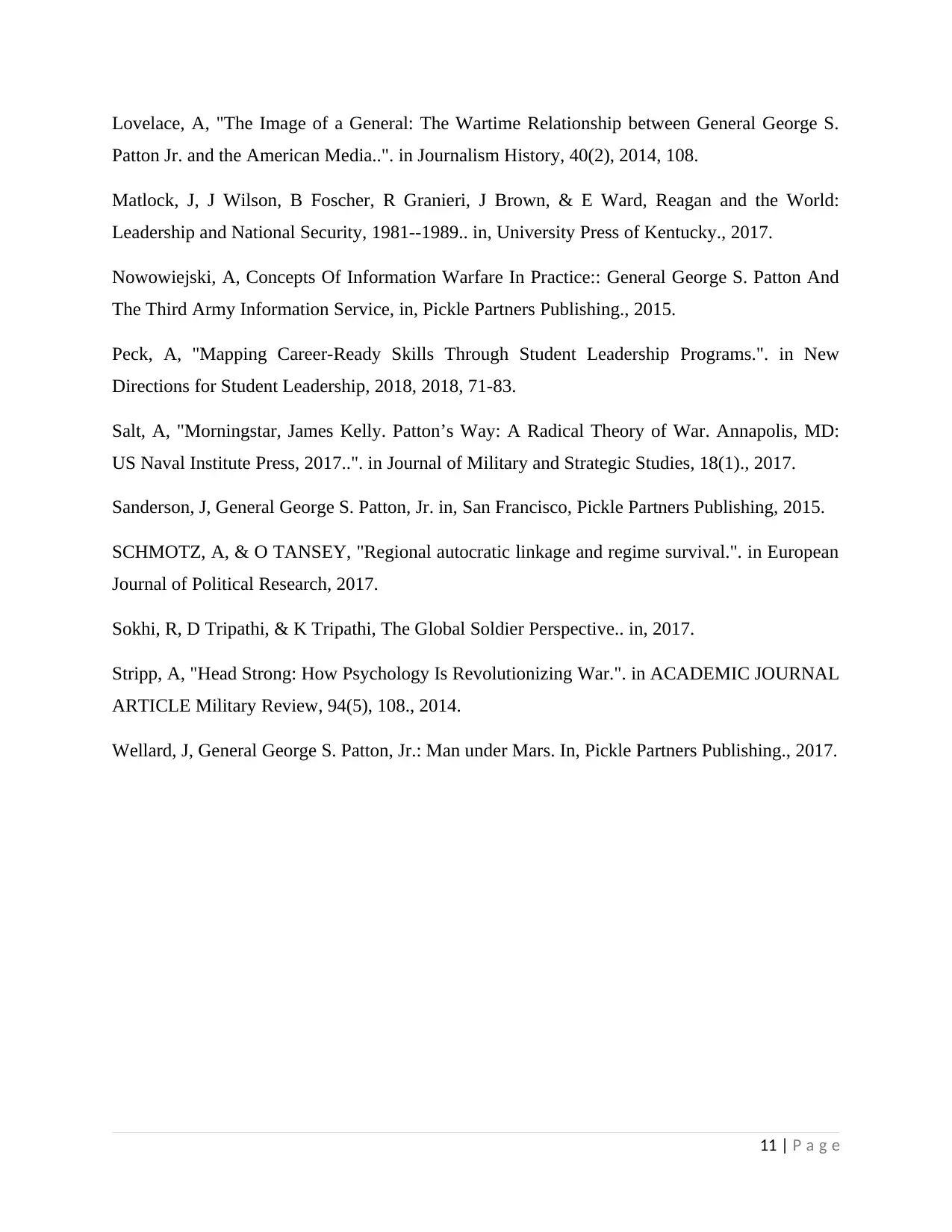
Lovelace, A, "The Image of a General: The Wartime Relationship between General George S.
Patton Jr. and the American Media..". in Journalism History, 40(2), 2014, 108.
Matlock, J, J Wilson, B Foscher, R Granieri, J Brown, & E Ward, Reagan and the World:
Leadership and National Security, 1981--1989.. in, University Press of Kentucky., 2017.
Nowowiejski, A, Concepts Of Information Warfare In Practice:: General George S. Patton And
The Third Army Information Service, in, Pickle Partners Publishing., 2015.
Peck, A, "Mapping Career-Ready Skills Through Student Leadership Programs.". in New
Directions for Student Leadership, 2018, 2018, 71-83.
Salt, A, "Morningstar, James Kelly. Patton’s Way: A Radical Theory of War. Annapolis, MD:
US Naval Institute Press, 2017..". in Journal of Military and Strategic Studies, 18(1)., 2017.
Sanderson, J, General George S. Patton, Jr. in, San Francisco, Pickle Partners Publishing, 2015.
SCHMOTZ, A, & O TANSEY, "Regional autocratic linkage and regime survival.". in European
Journal of Political Research, 2017.
Sokhi, R, D Tripathi, & K Tripathi, The Global Soldier Perspective.. in, 2017.
Stripp, A, "Head Strong: How Psychology Is Revolutionizing War.". in ACADEMIC JOURNAL
ARTICLE Military Review, 94(5), 108., 2014.
Wellard, J, General George S. Patton, Jr.: Man under Mars. In, Pickle Partners Publishing., 2017.
11 | P a g e
Patton Jr. and the American Media..". in Journalism History, 40(2), 2014, 108.
Matlock, J, J Wilson, B Foscher, R Granieri, J Brown, & E Ward, Reagan and the World:
Leadership and National Security, 1981--1989.. in, University Press of Kentucky., 2017.
Nowowiejski, A, Concepts Of Information Warfare In Practice:: General George S. Patton And
The Third Army Information Service, in, Pickle Partners Publishing., 2015.
Peck, A, "Mapping Career-Ready Skills Through Student Leadership Programs.". in New
Directions for Student Leadership, 2018, 2018, 71-83.
Salt, A, "Morningstar, James Kelly. Patton’s Way: A Radical Theory of War. Annapolis, MD:
US Naval Institute Press, 2017..". in Journal of Military and Strategic Studies, 18(1)., 2017.
Sanderson, J, General George S. Patton, Jr. in, San Francisco, Pickle Partners Publishing, 2015.
SCHMOTZ, A, & O TANSEY, "Regional autocratic linkage and regime survival.". in European
Journal of Political Research, 2017.
Sokhi, R, D Tripathi, & K Tripathi, The Global Soldier Perspective.. in, 2017.
Stripp, A, "Head Strong: How Psychology Is Revolutionizing War.". in ACADEMIC JOURNAL
ARTICLE Military Review, 94(5), 108., 2014.
Wellard, J, General George S. Patton, Jr.: Man under Mars. In, Pickle Partners Publishing., 2017.
11 | P a g e
⊘ This is a preview!⊘
Do you want full access?
Subscribe today to unlock all pages.

Trusted by 1+ million students worldwide
1 out of 12
Your All-in-One AI-Powered Toolkit for Academic Success.
+13062052269
info@desklib.com
Available 24*7 on WhatsApp / Email
![[object Object]](/_next/static/media/star-bottom.7253800d.svg)
Unlock your academic potential
Copyright © 2020–2026 A2Z Services. All Rights Reserved. Developed and managed by ZUCOL.
